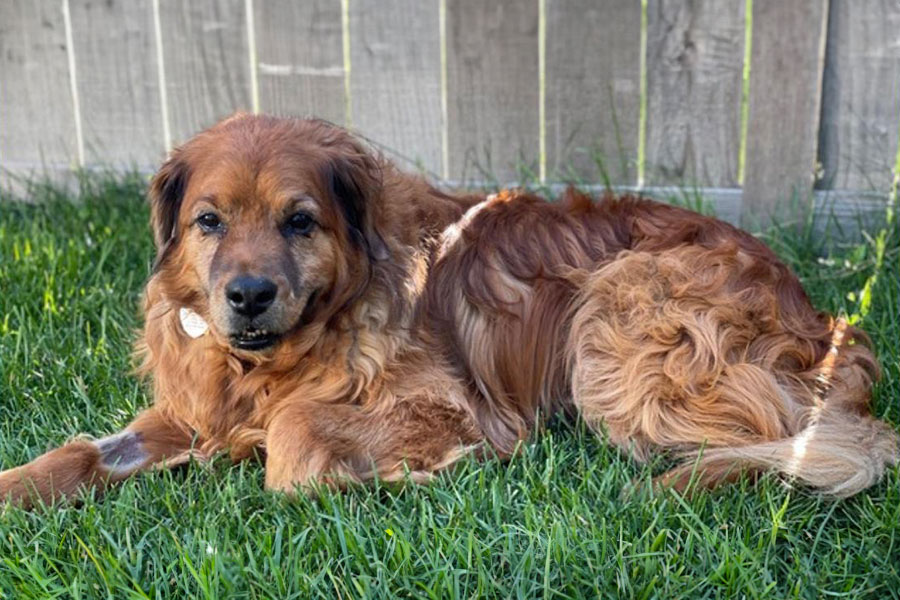
Charlie, a 13-year-old golden retriever/beagle/basset hound mix, had a tough start in life. He came to Minnesota from Alabama after spending his first six months as a stray.
“He had mange, and he was covered in ticks,” describes his owner Jason Flynn. “Long story short, he’s been with us ever since—happily ever after.”
As much as the move changed Charlie’s life, it changed the life of his new family as well. For Jason, his wife Stacey Boggs, and their 11-year-old son Rhone, Charlie’s sociable, super-affectionate ways are part of the fabric of their daily lives.
So when they woke one morning in April to find Charlie lethargic and unwilling to get up, they knew something was wrong.
“He lets us know when he doesn’t feel good,” Flynn says, “and that day he was definitely letting us know.”
They brought Charlie to the University of Minnesota Veterinary Medical Center (VMC), where the care team who examined him suspected—and confirmed through testing—that he was experiencing abdominal bleeding. Most often, the care team knew, this kind of bleeding was caused by a bleeding tumor of the spleen. Without surgery to remove his spleen, Charlie would die that day.
In roughly 40 percent of patients who experience the bleeding that Charlie did, the condition is benign and surgery alone is effective. But for many of the remaining dogs, a cancer arising from blood-vessel-forming cells called hemangiosarcoma is the cause of their bleeding. Canine splenic hemangiosarcoma is an aggressive cancer for which treatment options are limited. For those dogs, surgery prolongs their life on average only one to three months. When combined with standard chemotherapy, they may live four to six months.
It’s devastating news for any pet owner to receive. However, a clinical trial aimed at exploring new treatment pathways could offer a promising option for dogs like Charlie.
The VMC is part of the UMN College of Veterinary Medicine, which also is home to the Veterinary Clinical Investigation Center (CIC). The CIC supports more than 40 clinical trials that may lead to new drugs, devices, procedures, and treatments. Several of these trials focus on helping dogs diagnosed with cancer.
The family enrolled Charlie in a trial that seeks to improve outcomes for dogs with hemangiosarcoma by furthering our understanding of the disease and current and experimental treatments. Researchers analyze tumor and blood samples and track the patients’ outcomes to better understand what treatments provide the best chance at extending both length and quality of life.
“I am very excited to be a part of this multidisciplinary collaboration where researchers from different organizations have an opportunity to test new concepts while conducting a clinical trial,” says Antonella Borgatti, director of the Clinical Investigation Center and principal investigator for the trial. “We are all working toward a common goal, which is to contribute to finding curative outcomes for dogs with hemangiosarcoma. We could not do this without the support and dedication of dogs like Charlie and their amazing families.”
For Charlie’s family, the trial provided them with some hope.
“The fact that the trial exists made it a lot easier to make the difficult decision to go forward with treatment,” Flynn says. “We decided to do the surgery because of the possibility to try a new treatment and see if outcomes are better than surgery and standard chemotherapy alone. And knowing that those additional options are covered financially through the study provided some peace of mind.”
At Charlie’s last recheck, his care team was thrilled to report that his recent imaging showed no evidence of cancer progression in his chest or abdomen. While there’s no guarantee of what the future will bring for Charlie with the experimental therapy, he and his family are happy to enjoy the present.
“He’s alert, he’s happy, he’s eager to eat and go on walks. He’s really back to his old self,” Flynn says. “It’s been a win-win. We’re happy to be able to add to the body of knowledge of veterinary science while trying to keep Charlie healthy and happy.”
This story was adapted from the original at the College of Veterinary Medicine.
- Categories:
- Health
- Animals
- Health conditions




